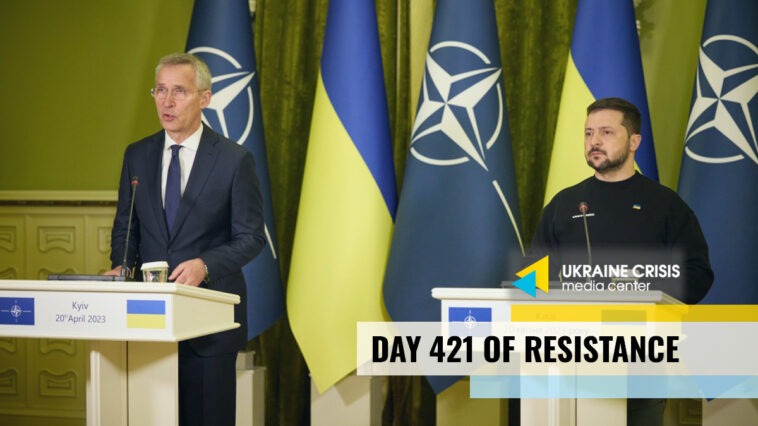NATO Secretary General Jens Stoltenberg makes an unannounced visit to Kyiv. Russian-installed Sevastopol authorities cancel May 9 parade. Ukraine needs to resupply its air defense systems.
NATO Secretary General Jens Stoltenberg makes surprise visit to Kyiv
On Thursday, April 20, NATO Secretary General Jens Stoltenberg made an unannounced visit to Kyiv, for the first time since Russia launched a full-scale invasion of Ukraine.
“I am here today with a simple message: NATO stands with Ukraine,” Stoltenberg told a joint news conference in Kyiv with Ukrainian President Volodymyr Zelenskyi.
“Today, the President and I discussed a multi-year support initiative. It is a testament to NATO’s long-term commitment to Ukraine. NATO stands with you today, tomorrow and for as long as it takes,” NATO Secretary General said.
The Alliance stood by Ukraine after Russia illegally annexed Crimea in 2014, Stoltenberg said. It stands by Ukraine today, “in your heroic fight against the Russian invaders”, and “will stand by you tomorrow, as you rebuild, and work toward a brighter future for the Ukrainian people,” he added.
Russian aggression is a toxic pattern that must be stopped, Stoltenberg emphasized. The Allies must continue strengthening Ukraine’s armed forces, he added.
“We must ensure that robust, powerful arrangements are in place for Ukraine’s security. Ukraine’s rightful place is in the Euro-Atlantic family. Ukraine’s rightful place is in NATO. And over time, our support will help you make this possible,” NATO Secretary General said.
When asked about NATO’s July summit in Vilnius, Stoltenberg said: “I also recognize that President Zelenskyi will raise the issue of [Ukraine’s NATO] membership, of security guarantees, and this will be high on the agenda of the meeting.”
Stoltenberg also visited Bucha.
Ukraine’s air defenses destroy 1,500 Russian targets since autumn last year, need resupply
Ukraine needs more air defense systems and associated munitions, after burning through missiles, while fighting off massive Russian strikes last fall and winter, spokesperson for the Ukrainian Air Force Command Colonel Yuriy Ihnat said on television.
“Our expectation is that our allies will send us not only more [air defense] systems, but also more missiles for them, as our rate of missile expenditure is serious. Last fall and winter, the enemy targeted our [energy] infrastructure. Ukraine’s air defenses destroyed 750 kamikaze drones and the same number of missiles. (Russia launched a total of 850 cruise missiles in those months – edit.) That makes a total of 1,500 Russian targets intercepted by Ukraine’s air defense systems. Since the invasion, Ukrainian troops have destroyed 600 aircraft and helicopters, and at least 1,500 drones,” Ihnat said.
“We use large amounts of missiles, and they need to be replenished at a corresponding rate. We hope that the next ‘Ramstein’ meeting [of the Ukraine Defense Contact Group] will bring us expected results and good news,” he added.
Russian-installed Sevastopol authorities scrap May 9 parade
According to Mikhail Razvozhayev, the governor of Sevastopol annexed by Russia, Russia will not hold a Victory Day military parade in the city.
Instead, there will be commemorative parades near veterans centers, he added.
On April 12, the Russian-appointed head of Crimea, Sergey Aksyonov, said that there would be no parades in Crimea either on May 1 or May 9. At the time, Razvozhayev said that no decision had been made to cancel the May 9 parade in the city. Consultations with the Russian Defense Ministry were still underway, he added.
The governors of Russia’s Kursk and Belgorod regions earlier scrapped the May 9 parade “in order not to provoke the enemy with concentrations of troops and equipment”.
Challenges and prospects of art during the war. Ukraine in Flames #406
The war affects all spheres of life without exception, and creativity, as the most sensitive, reacts to the experiences in the most touching way. War reflections are expressed not only through modern art, but also penetrate into more conservative and traditional genres, such as icon painting. Folklore and traditions also change, because it is all a reflection of life, and one cannot help but react to its changes. Watch Ukraine in flames #406 to find out about how war affects art and how art depicts war.
Guests:
- Kostyantyn Cherniavskyi, Head of the National Union of Artists of Ukraine
- Halyna Hryhorenko, Deputy Minister of Culture and Information Policy of Ukraine




